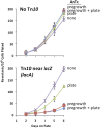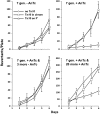Plasmid copy number underlies adaptive mutability in bacteria
- PMID: 25173846
- PMCID: PMC4224180
- DOI: 10.1534/genetics.114.170068
Plasmid copy number underlies adaptive mutability in bacteria
Abstract
The origin of mutations under selection has been intensively studied using the Cairns-Foster system, in which cells of an Escherichia coli lac mutant are plated on lactose and give rise to 100 Lac+ revertants over several days. These revertants have been attributed variously to stress-induced mutagenesis of nongrowing cells or to selective improvement of preexisting weakly Lac+ cells with no mutagenesis. Most revertant colonies (90%) contain stably Lac+ cells, while others (10%) contain cells with an unstable amplification of the leaky mutant lac allele. Evidence is presented that both stable and unstable Lac+ revertant colonies are initiated by preexisting cells with multiple copies of the F'lac plasmid, which carries the mutant lac allele. The tetracycline analog anhydrotetracycline (AnTc) inhibits growth of cells with multiple copies of the tetA gene. Populations with tetA on their F'lac plasmid include rare cells with an elevated plasmid copy number and multiple copies of both the tetA and lac genes. Pregrowth of such populations with AnTc reduces the number of cells with multiple F'lac copies and consequently the number of Lac+ colonies appearing under selection. Revertant yield is restored rapidly by a few generations of growth without AnTc. We suggest that preexisting cells with multiple F'lac copies divide very little under selection but have enough energy to replicate their F'lac plasmids repeatedly until reversion initiates a stable Lac+ colony. Preexisting cells whose high-copy plasmid includes an internal lac duplication grow under selection and produce an unstable Lac+ colony. In this model, all revertant colonies are initiated by preexisting cells and cannot be stress induced.
Keywords: adaptive mutation; gene amplification; mutation under selection; selection; stress-induced mutagenesis.
Copyright © 2014 by the Genetics Society of America.
Figures










Similar articles
-
Selection and Plasmid Transfer Underlie Adaptive Mutation in Escherichia coli.Genetics. 2018 Nov;210(3):821-841. doi: 10.1534/genetics.118.301347. Epub 2018 Sep 7. Genetics. 2018. PMID: 30194073 Free PMC article.
-
Selection-Enhanced Mutagenesis of lac Genes Is Due to Their Coamplification with dinB Encoding an Error-Prone DNA Polymerase.Genetics. 2018 Mar;208(3):1009-1021. doi: 10.1534/genetics.117.300409. Epub 2018 Jan 4. Genetics. 2018. PMID: 29301907 Free PMC article.
-
Selective Inbreeding: Genetic Crosses Drive Apparent Adaptive Mutation in the Cairns-Foster System of Escherichia coli.Genetics. 2020 Feb;214(2):333-354. doi: 10.1534/genetics.119.302754. Epub 2019 Dec 6. Genetics. 2020. PMID: 31810989 Free PMC article.
-
The Origin of Mutants Under Selection: How Natural Selection Mimics Mutagenesis (Adaptive Mutation).Cold Spring Harb Perspect Biol. 2015 Jul 1;7(7):a018176. doi: 10.1101/cshperspect.a018176. Cold Spring Harb Perspect Biol. 2015. PMID: 26134316 Free PMC article. Review.
-
Amplification-mutagenesis--how growth under selection contributes to the origin of genetic diversity and explains the phenomenon of adaptive mutation.Res Microbiol. 2004 Jun;155(5):342-51. doi: 10.1016/j.resmic.2004.01.016. Res Microbiol. 2004. PMID: 15207866 Review.
Cited by
-
Salvador Luria and Max Delbrück on Random Mutation and Fluctuation Tests.Genetics. 2016 Feb;202(2):367-8. doi: 10.1534/genetics.115.186163. Genetics. 2016. PMID: 26869479 Free PMC article. No abstract available.
-
Environmental pleiotropy and demographic history direct adaptation under antibiotic selection.Heredity (Edinb). 2018 Nov;121(5):438-448. doi: 10.1038/s41437-018-0137-3. Epub 2018 Sep 6. Heredity (Edinb). 2018. PMID: 30190561 Free PMC article.
-
Selection and Plasmid Transfer Underlie Adaptive Mutation in Escherichia coli.Genetics. 2018 Nov;210(3):821-841. doi: 10.1534/genetics.118.301347. Epub 2018 Sep 7. Genetics. 2018. PMID: 30194073 Free PMC article.
-
Natural selection underlies apparent stress-induced mutagenesis in a bacteriophage infection model.Nat Microbiol. 2016 Apr 18;1(6):16047. doi: 10.1038/nmicrobiol.2016.47. Nat Microbiol. 2016. PMID: 27572836
-
Death and population dynamics affect mutation rate estimates and evolvability under stress in bacteria.PLoS Biol. 2018 May 11;16(5):e2005056. doi: 10.1371/journal.pbio.2005056. eCollection 2018 May. PLoS Biol. 2018. PMID: 29750784 Free PMC article.
References
-
- Andersson D. I., Slechta E. S., Roth J. R., 1998. Evidence that gene amplification underlies adaptive mutability of the bacterial lac operon. Science 282: 1133–1135. - PubMed

